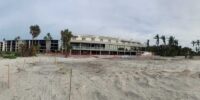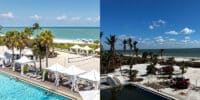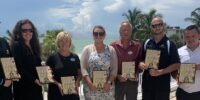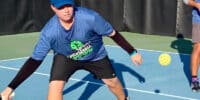Learning about Sanibel Marine Life
Sundial is proud to be the location of Sanibel Sea School’s satellite campus. In fact, we have live tanks on site that are used to house found specimens and a classroom to help teach our guests more about the local ecology. We asked Kalli Unthank of Sanibel Sea School to show us around the tanks and the classroom and share some of her marine knowledge.
So Kalli, tell us about the tanks. Where do the creatures come from? How long are they in the tanks? What are some of the more common ones and what are some of the rare finds that have been in the tank?
All of our critters are local and caught by Sea School students! We either catch them right off the Sundial beach or take a field trip to different locations around Sanibel. One of our favorite spots to fish is off the causeway islands, where there are huge seagrass beds. These seagrass beds provide a nursery habitat for a variety of creatures, giving our students ample opportunity to catch juvenile fish, crabs, seahorses and more!
We have a Special Activity License from the Florida Fish and Wildlife Conservation Commission that allows us to catch and keep critters for up to 30 days. This allows us to show students and guests the diversity of wildlife found in the Sanibel waters.
The most common fish we catch are probably Pinfish and Mojarra. Many people use these as bait fish. Blue crabs and spider crabs are caught almost every time we go out. We also commonly find pufferfish (pictured above), which is a big hit with the kids. On lucky days, we will find seahorses but we can’t keep these in our tanks because they need to be fed constantly. Fun Fact: Seahorses don’t have stomachs so food passes through their system quickly. Right now we have our first Grass Porgy in the tanks. This fish is really cool because you can see how well he blends into the seagrass with the green stripes on his body. Another uncommon fish we currently have is a Stargazer (pictured below). When they are big enough, they can even give a small electric shock!
Where is the large skull from and what do you use it for?
Any skulls we have are donated or found by Sea School Educators. As an educational facility, we are allowed to have these specimens to use in our classes and for display but normally, beachgoers cannot keep skeletons from marine mammals or endangered species. We use the dolphin skull to teach students about the anatomy of dolphins. The skull shows us the mechanics behind the dolphin’s use of echolocation, it’s diet based on their teeth, where the blowhole would be, and more! When kids have the opportunity to hold a dolphin skull in their hand, rather than just look at a picture, it gives them a real opportunity to feel out exactly where all the components of the dolphin head are located and see how everything fits together. It’s a much more memorable experience that way.
What are some of the more unique items displayed in the sea school classroom?
Along with the dolphin skull, we also have a loggerhead sea turtle skull. These are the most common sea turtles found on Sanibel during the nesting season. We also have sea turtle rib bones, hypoplastrons (these are part of the sea turtle underside) and scutes, which are the scales on the sea turtle shell.
Our shell wall is also a great resource for shellers of all levels! We have many commonly found shells displayed with their common and scientific names, along with some other marine debris that washes up on our beaches. If you ever find anything and you aren’t quite sure what it is, or want to know the name of a shell you found, we probably have it displayed on our shell wall!
What are some common finds that people could see on your display then be likely to find themselves?
Aside from the shells, beachgoers can commonly find sand dollars on the beaches here (make sure they aren’t alive before taking them out of their habitat). They can also find fish skulls and bone, usually red or black drums. Crab claws and carapaces are a cool find and are usually molts, not dead crabs. When a crab outgrows its exoskeleton, it absorbs water and pushes out, leaving behind a shell-like structure that looks exactly like the crab when it was alive.
Another common find that looks very strange are snail egg casings. These are found in the spring and summer months and look like spiraled tubes (lightning/pear whelks) or a bubbly mass (horse conch).
What are some of the most asked questions you get?
We get asked about the best shelling spots on Sanibel (Sundial has great shelling, as does Blind Pass) and where you can see dolphins (although they are wild animals and cannot be predictable, I commonly see them in the mornings at Lighthouse Beach). Manatees are another big critter people look out for and you can commonly see those in marinas where the water is a bit warmer than the open ocean. We are always helping people identify shells but commonly get asked about pig bones (if you find any small, thick bones on the beach, those are from pig meat being used as bait in crab traps).
People also ask where the shells come from, as in how they are created. What a lot of people don’t know is that shells are formed by the snail creature that lives inside them. The shell is already formed when the snail is born (because it is the shell’s exoskeleton) and continues to grow as the snail grows. One cannot grow without the other. The shells are made of calcium carbonate that the snail absorbs from the water, then layers onto the shells.
To find out more about the programs available at Sundial with Sanibel Sea School, please visit our website.









